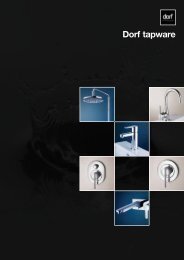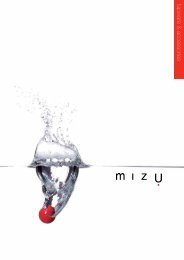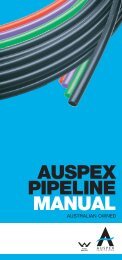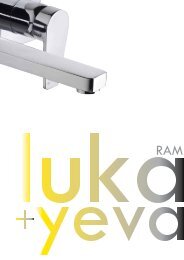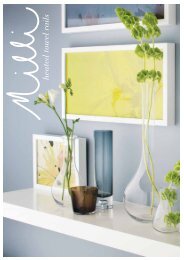Raupiano Plus Technical Infomation | Rehau | Reece Plumbing
Raupiano Plus Technical Infomation | Rehau | Reece Plumbing
Raupiano Plus Technical Infomation | Rehau | Reece Plumbing
Create successful ePaper yourself
Turn your PDF publications into a flip-book with our unique Google optimized e-Paper software.
6.13 Installing pipes in concrete<br />
6.14 Installation above suspended ceilings<br />
6.16 Installation as stormwater piping<br />
When installing in concrete, we recommend decoupling the pipelines from<br />
the main structure by using common moisture-protected structure-borne<br />
noise insulations with a thickness greater than 4 mm. A limitation of the<br />
sound-insulation effectiveness can be expected, however.<br />
- Attach pipe components in such a way that a change in position during<br />
concrete application is prevented.<br />
- Ensure sufficient expansion joints when installing the pipe.<br />
- Seal off sleeve gap with adhesive strips to prevent the penetration of<br />
concrete.<br />
- Seal off pipe openings before concrete application.<br />
CAUTION<br />
Danger of damage to property!<br />
Damage to the pipelines!<br />
- Avoid placing the weight of the concrete on the pipelines by making<br />
provisions for dissipating the load, e.g. by using:<br />
- Spacers in the case of reinforcing steels<br />
- Carrying boxes<br />
- Brackets<br />
- Avoid walking on the pipes during concrete application.<br />
Installation above suspended ceiling might require additional acoustic<br />
measures to ensure a high degree of sound insulation. The additional<br />
acoustic measures depend on a few factors:<br />
- The room type directly underneath the piping (wet areas, bedroom or<br />
other habitable rooms)<br />
- The construction type of the building<br />
- The type of plasterboard used as suspended ceiling<br />
- The expected water flow rate within the particular drainage line<br />
- The desired acoustic level to be achieved<br />
In general, it is unnecessary to take extra measures to sound-insulate<br />
RAUPIANO <strong>Plus</strong> system when it is installed above wet areas and other<br />
habitable rooms, with water flow rate taken into consideration. But if a<br />
very high degree of acoustic requirement is specified for that particular<br />
room, it is necessary to wrap RAUPIANO <strong>Plus</strong> system with sound<br />
insulation that passes above that room.<br />
6.15 Ceiling penetrations<br />
Ceiling penetrations must be constructed to be moisture-proof and<br />
sound-insulating. Fire-protection measurements may be necessary if<br />
pipes penetrate through fire-rated building elements. Refer to chapter 4<br />
for details.<br />
If mastic asphalt is to be applied to the floor:<br />
Protect exposed pipeline components with ceiling liner, protective sleeves<br />
or by winding them with heat-insulating materials.<br />
There is a risk of dew formation on the pipes installed as stormwater<br />
piping within the building.<br />
Condensation water appears when the temperature of the pipe walls<br />
drops below the dew point temperature of the ambient air due to cold rain<br />
water, for example. Humidity from the ambient air then condenses on the<br />
pipe surface.<br />
For this reason, all pipelines in the building on which condensation water<br />
could form are to be provided with diffusion-proof insulation material.<br />
Insulation of the collecting pipes in the cellar can be dispensed with if<br />
there is no risk of dew formation. In general, this is the case with exposed<br />
stormwater piping in unheated cellars if temperature equalisation occurs.<br />
Condensation-water insulation materials<br />
Closed-cell materials with high water vapour diffusion resistance are<br />
recommended for use as condensation-water insulation. If open-cell or<br />
fibrous insulation materials are used, they must have an impermeable<br />
outer layer that is firmly attached to the insulation material.<br />
- Close off all impact, groove, cut and end points of the insulation with a<br />
permanent seal.<br />
- Cut out insulation in the bracket area.<br />
- Pull insulation material over the bracketed section and permanently<br />
seal it to the neighbouring insulation material with adhesive.<br />
Fixing of stormwater piping<br />
To prevent the pipelines from sliding apart, a security clamp is to be<br />
attached to the pipe directly below the supporting clamp.<br />
Fig. 6-13<br />
Recommended ceiling penetration practices.<br />
30 31



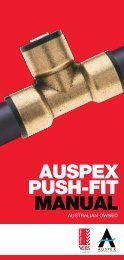

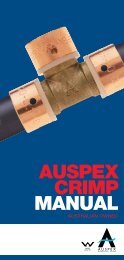
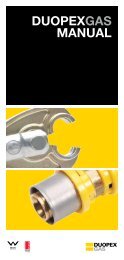
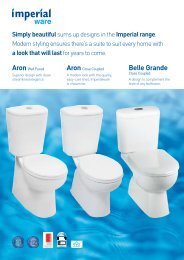
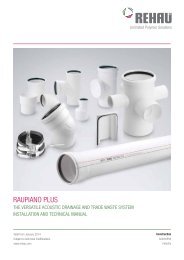
![Financial Reports Year Ending 30 June 2009 [PDF] - Reece](https://img.yumpu.com/43916436/1/184x260/financial-reports-year-ending-30-june-2009-pdf-reece.jpg?quality=85)
